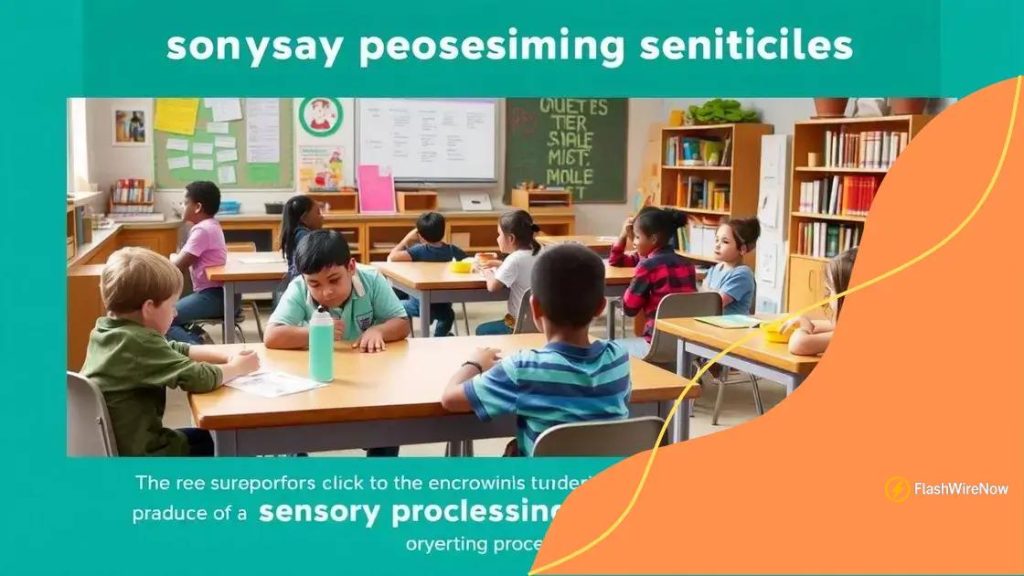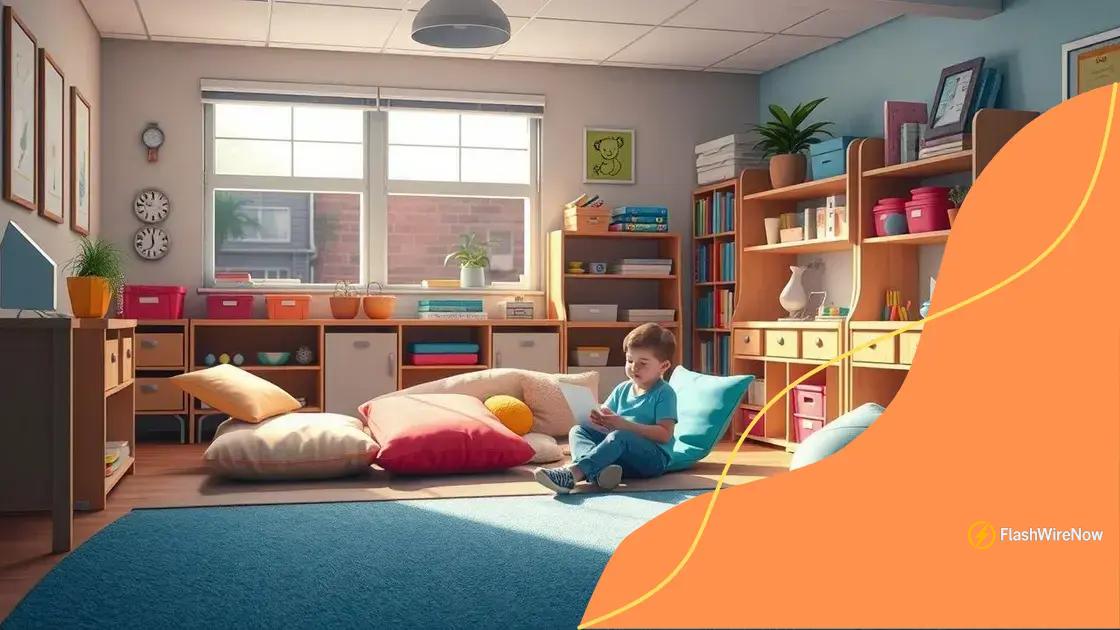Supporting students with sensory processing sensitivities effectively

Anúncios
Supporting students with sensory processing sensitivities involves creating inclusive environments, utilizing effective resources, and fostering open communication between parents and educators to enhance learning and support individual needs.
Supporting students with sensory processing sensitivities is crucial for fostering a conducive learning atmosphere. Have you ever noticed a child struggling to concentrate because of noise or bright lights? In this article, we’ll explore simple yet effective methods to assist those students in thriving academically.
Anúncios
Understanding sensory processing sensitivities
Sensory processing sensitivities can deeply affect a student’s daily life and learning experience. Understanding sensory processing sensitivities is the first step in providing appropriate support. It is essential to recognize how these sensitivities manifest, as they can vary significantly from one student to another.
What Are Sensory Processing Sensitivities?
Many students experience sensory processing sensitivities, which means their brains process sensory information differently. This can lead to challenges in school settings, especially if the environment is overwhelming.
Common Experiences
Students with these sensitivities may react strongly to:
Anúncios
- Bright lights.
- Loud noises.
- Certain textures or fabrics.
- Strong smells.
These reactions can lead to feelings of anxiety, frustration, or discomfort, making it difficult for them to focus or participate in class activities. Teachers and parents can work together to identify these challenges to help students feel more at ease.
Why Understanding Is Important
Awareness of a student’s sensory processing sensitivities cultivates an environment of acceptance and support. By understanding their unique experiences, educators can implement strategies that enhance their learning potential.
Promoting awareness fosters compassion and leads to collaboration among peers. When students understand each other’s challenges, they can create a more inclusive and supportive classroom environment.
Furthermore, investing time to recognize and accommodate these sensitivities encourages a sense of belonging for students, making them feel valued and understood. This is vital for their overall well-being and academic success.
Common challenges faced by students
Students with sensory processing sensitivities face various challenges that can affect their learning and social interactions. Identifying these common challenges is crucial for educators and parents to provide the right support.
Difficulty with Sensory Overload
One of the main challenges is sensory overload, where students become overwhelmed by environmental stimuli. This can lead to anxiety or even meltdowns. Often, classrooms can be quite stimulating, with bright lights and loud noises, which can be difficult for these students to handle.
Social Interactions
Social interactions can also pose a challenge. Students with sensory sensitivities might find it hard to engage with peers during group activities. They may avoid certain social settings due to fear of being overwhelmed, leading to feelings of loneliness.
Concentration Issues
Poor concentration is another common issue. When distractions arise, students may struggle to focus on their tasks. The constant need to filter out unnecessary sensory input can be mentally exhausting.
- Example environments that can cause overload include:
- Lunchrooms filled with noise.
- Classrooms with flickering fluorescent lights.
- Busy hallways during transitions.
Addressing these challenges requires understanding and proactive measures. Teachers can provide a quieter space for students to retreat to when needed. Additionally, clear routines can help these students feel more secure and focused.
Recognizing these challenges allows educators to develop strategies tailored to individual needs. By providing options like flexible seating or sensory breaks, teachers can create a more inclusive environment.
Effective strategies for support

Implementing effective strategies for support is essential in helping students with sensory processing sensitivities thrive in the classroom. By understanding their specific needs, educators can create a tailored approach that fosters learning and comfort.
Creating Sensory-Friendly Spaces
Designing a sensory-friendly environment is an important first step. Lightening up bright lights and reducing background noise can significantly help. Allowing students to utilize calming tools, such as fidget toys, can support their focus.
Offering Sensory Breaks
Another effective strategy is to provide regular sensory breaks during the school day. When students can take brief walks or engage in calming activities, it helps to reset their sensory systems. This break can improve concentration and reduce feelings of overwhelm.
Individualized Learning Plans
Developing individualized learning plans can also benefit students with these sensitivities. These plans can outline specific accommodations tailored to each student’s needs, such as extra time on tests or alternative methods of showing learning.
- Key strategies to consider include:
- Using visual schedules to help students anticipate activities.
- Incorporating quiet spaces for students to retreat when needed.
- Allowing flexibility in seating arrangements.
- Encouraging mindfulness practices to help them manage stress.
By taking these steps, educators can establish a more inclusive classroom that actively supports each student’s unique sensory needs. Communicating regularly with parents and specialists can enhance the effectiveness of the strategies implemented.
Establishing a partnership between teachers, parents, and the students themselves is crucial for success. When everyone works together, the support provided can make a lasting impact on students’ educational experiences.
Creating an inclusive classroom environment
Creating an inclusive classroom environment is vital for students with sensory processing sensitivities. It helps them feel safe and valued, allowing them to participate fully in their education. A welcoming space can make a significant difference.
Flexible Seating Arrangements
One way to foster inclusion is by offering flexible seating options. Providing a variety of seating arrangements, from traditional desks to bean bags or cushioned areas, allows students to choose what makes them comfortable. This flexibility can help students focus better on their work.
Visual Supports
Utilizing visual supports is another effective strategy. Visual schedules and clear instructions can assist students in knowing what to expect, reducing anxiety. For students who struggle with verbal instructions, visuals can provide clarity.
Positive Behavior Systems
Implementing a positive behavior system encourages a respectful classroom culture. Recognizing and celebrating small successes can boost confidence and foster a sense of belonging among all students.
- Strategies for an inclusive environment may include:
- Establishing quiet areas for students to take breaks.
- Offering sensory tools to help manage stress.
- Creating group activities that encourage teamwork.
- Promoting open communication about sensory needs.
Involving all students in the planning of classroom activities can also enhance inclusivity. When students contribute ideas, they feel more engaged and responsible for their environment. It’s essential to regularly assess how the classroom impacts students and make adjustments based on their feedback.
Encouraging a culture of acceptance among peers can help students with sensory processing sensitivities feel supported. Teaching empathy and understanding will strengthen relationships and improve collaborative efforts in the classroom.
Resources for educators and parents
There are many resources for educators and parents that can help support students with sensory processing sensitivities. These resources offer valuable insights and practical tools to create an effective learning environment.
Books and Guides
Books focused on sensory processing can provide a wealth of information. They often cover strategies for managing sensitivities and creating inclusive spaces. Some titles are particularly helpful for understanding the challenges faced by students.
Online Courses and Webinars
Many organizations offer online courses or webinars that cover sensory processing issues. These educational opportunities allow educators and parents to gain a deeper understanding of how to support affected students.
Professional Organizations
Connecting with professional organizations can provide additional resources and support. These organizations often host conferences and workshops tailored to sensory processing challenges.
- Helpful resources include:
- Websites dedicated to sensory processing disorder.
- Support groups for educators and parents.
- Educational videos that demonstrate effective strategies.
- Newsletters with updated information and tips.
Technology can also play a role in supporting sensory needs. Apps that offer mindfulness exercises or sensory regulation techniques can be beneficial for both students and teachers. Encouraging open communication between parents and educators is crucial to make effective use of these resources.
By utilizing these tools, parents and educators can work together to create an environment that recognizes and addresses the unique needs of students with sensory processing sensitivities. Building a network of support enriches the educational experience for everyone involved.
FAQ – Frequently Asked Questions about Supporting Students with Sensory Processing Sensitivities
What are sensory processing sensitivities?
Sensory processing sensitivities refer to how some students process sensory information differently, which can lead to challenges in environments like classrooms.
How can educators support students with sensory processing sensitivities?
Educators can create inclusive environments, utilize sensory-friendly resources, and provide individualized support to help these students thrive.
What resources are available for parents and educators?
There are many resources, including books, online courses, and professional organizations, that provide guidance on supporting students with sensory sensitivities.
Why is communication important between parents and educators?
Open communication helps ensure that both parties understand the needs of the student, allowing for better support and a more effective learning environment.





